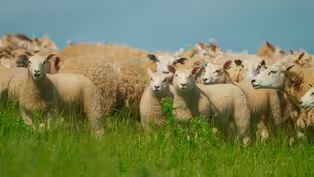
Buried in Style: Fashion’s Final Destination
Clip: Season 2 Episode 3 | 12m 3sVideo has Closed Captions
From catwalk to castoff, Shane follows our tossed threads to the Chilean desert.
Fashion historian Clare Sauro and journalist John Bartlett trace the hidden costs of fast fashion. From cheap, short-lived trends to mountains of textile waste dumped in Chile’s Atacama Desert, they expose how global supply chains and impulsive shopping habits fuel an environmental crisis — and why what we wear says more about us than we think.
Problems playing video? | Closed Captioning Feedback
Problems playing video? | Closed Captioning Feedback

Buried in Style: Fashion’s Final Destination
Clip: Season 2 Episode 3 | 12m 3sVideo has Closed Captions
Fashion historian Clare Sauro and journalist John Bartlett trace the hidden costs of fast fashion. From cheap, short-lived trends to mountains of textile waste dumped in Chile’s Atacama Desert, they expose how global supply chains and impulsive shopping habits fuel an environmental crisis — and why what we wear says more about us than we think.
Problems playing video? | Closed Captioning Feedback
How to Watch Human Footprint
Human Footprint is available to stream on pbs.org and the free PBS App, available on iPhone, Apple TV, Android TV, Android smartphones, Amazon Fire TV, Amazon Fire Tablet, Roku, Samsung Smart TV, and Vizio.
Buy Now

Surprising Moments from Human Footprint
Do you think you know what it means to be human? In Human Footprint, Biologist Shane Campbell-Staton asks us all to think again. As he discovers, the story of our impact on the world around us is more complicated — and much more surprising — than you might realize.Providing Support for PBS.org
Learn Moreabout PBS online sponsorship(whooshing) (horn blaring) (Clare) So, welcome to the Ecology of Fashion.
(whooshing) I absolutely love the clothes pile.
(Shane) In case it’s not obvious, that’s a heap of unwanted garments on display in a museum.
(Clare) We wanted something that would be surprising when people walked in.
(Shane) Yeah, it’s definitely that, for sure.
(Clare) It really gets right to the point of, you know, we have a problem.
(SZNS) ♪ I look good 24/7 ♪ ♪ I’m hot 24/7 ♪ (Shane) This is fashion historian Clare Sauro.
("24/7" by SZNS) And as much as she wishes this was her closet, it’s actually the historic costume collection she curates at Drexel University.
(SZNS) ♪ I’m hot 24/7 ♪ ♪ Dudes be like, "Ooh, she’s stunning" ♪ (Shane) In 2024, she co-created a new exhibit, the Ecology of Fashion.
(SZNS) ♪ I’m hot 24/7 ♪ (Shane) Old folks say, it’s like, "Oh, it’s, you know, it’s not made like it used to be," but I think when it comes to clothing, it actually seems like it’s not made like it used to be.
Absolutely.
A lot of mass-produced fashion today is only made to be worn about seven times before it starts pretty much falling apart.
Oh, wow.
According to Clare, knowing the difference between clothing and fashion can help us understand the dilemma we face today.
Where do you draw the line, then, between function, the sort of clothing part of it, and fashion?
I mean, we don’t really need all that much.
Really, you can just wear the same clothes over and over again and just replace them when they wear out.
Pretty much as soon as there’s available resources, we start doing things that really make no sense.
This is fashion with a capital F. (mellow music) It’s not logical, but that’s fashion.
(Shane) Fashion with a capital F might not help us survive the elements, but we’re a social species.
The ideas we express and identities we signal through fashion can mean everything.
(Clare) In the 19th century, you have more and more people participating in fashion, and, therefore, well, if my housemaid is wearing that, I’m not gonna wear it anymore, so it’s gonna speed up.
Almost kind of like an arms race.
-It is.
-Okay.
(explosions) (Shane) After World War II, with a very real arms race underway, synthetic textiles opened the door for America’s growing middle class to buy once inaccessible fashions.
(bright, old-fashioned music) ♪ (Clare) Big crinoline skirts, colorful lingerie, and all of these things that would have been out of reach for most people.
Things are brightly colored.
You can buy multiples.
It’s not so serious, it’s fun.
♪ That mindset is a very big shift.
♪ (Shane) With more people participating in high fashion, trends accelerated.
Designers created distinct seasonal collections for their upper-class customers, only to be copied by big, mainstream retailers.
And that was just the start.
(Clare) The internet has really changed everything.
(whooshing) (dial-up internet squealing) (man) You’ve got mail.
(energetic music) (Shane) Before the internet, major department stores would send sketch artists to fashion shows.
But it would be months before those sketches became mass-produced clothing.
♪ (Clare) Now, people snap pictures with their phones as the models are walking down the runway, and somebody’s copying it, like, immediately.
The turnaround on the copying, it’s unparalleled.
We’ve never had anything like that before.
And social media has exacerbated this.
(fast typing) ♪ Once a month turns into every two weeks, which turns into once a week.
(zipper zips) The consumer is trained to come back and to buy on novelty.
♪ (Shane) And the pace of trends has changed our relationship with what we wear.
(mysterious music) (Clare) I think the average person doesn’t appreciate what they have.
Because we buy impulsively, we sometimes do have a closet full of clothes and nothing to wear.
(Shane) That’s interesting, a closet full of clothes and nothing to wear.
(laughing) (machinery whirring) New global supply chains emerged to meet our insatiable demand for trendy, inexpensive apparel.
♪ (Clare) How can it be that inexpensive?
Corners have to be cut somewhere.
(sewing machines whirring) And it’s in the quality of the materials, it’s the quality of the workmanship, and the bottom line is the workers.
(bell rings) (Shane) The textile industry relies on 75 million workers worldwide, most of them working grueling hours to earn less than a living wage.
(grim music) All to keep our wardrobes full of cheap clothes we hardly use.
♪ (Clare) History has shown that we do things without thinking about the future.
Fashion, in particular, is very much a in-the-moment discipline.
(Shane) And when a new look catches our eye, it doesn’t matter whether it’s a $5,000 dress or a $5 shirt.
The last thing most of us think about is where it’ll go when we’re done with it.
♪ (cell phone ringing) (John) Well, I’ve done a lot of these environmental stories, but I’ve never seen anything like what I saw the first time I came to Iquique.
(energetic music) Visually, it was incredible.
The first thing you start to wonder is, like, why?
Why is that happening?
♪ (Shane) Meet journalist John Bartlett.
(whooshing) When he’s not playing cricket for Chile’s national team, he’s investigating the complicated story of fashion waste.
His recent story in National Geographic captured the world’s attention.
(John) When you walk through the market, you’d be amazed at the kind of things you find.
(mysterious music) (Shane) This is La Quebradilla, one of the largest open-air markets in South America.
But most of the clothes here come from the United States.
(energetic music) (John) I mean, this is from, like, a farmer’s coalition in the U.S. We’ve got, like, college volleyball down there.
This from Amazon.
There’s so many things commemorating sports tournaments that I don’t think even the fans of the team think about it anymore.
♪ (Shane) John investigated every stage of this second-hand economy, -starting at the port.
-(ship horn blasts) (John) The free port’s a really, really interesting place.
The reason it exists, really, is because Chile’s a strange-- strange-shaped country.
(soft music) (Shane) Iquique lies on the Pacific coast, nearly a thousand miles north of Chile’s capital, Santiago.
(John) And one of the ways they managed to make sure that the north of the country stayed Chilean was to create jobs up here.
(whooshing) And one of the ways of creating those jobs was to declare Iquique a free port; to create this sort of tax-free area where you could import goods without import duties.
(whooshing) (Shane) With no import tax, it became cheaper for U.S. businesses to ship their unwanted clothing here than it was to dispose of it at home.
(John) We were down at the port this morning and there was a huge container ship.
A lot of it will be clothing.
They come in these huge bundles, plastic wrapped and then bound with plastic bindings.
(mellow music) (Shane) Thousands of these bales are unloaded to importers’ warehouses.
(John) Teams of workers in the warehouses separate them out into-- usually into three categories.
♪ The first, which is basically new.
Often they come in with tags still attached.
And they’re either sold in these sort of premium warehouses or they are, incredibly, baled up again and shipped back to the U.S. for resale.
(Shane) Back to where they came from?
Yeah, yeah, for resale.
I mean, environmentally, it’s catastrophic.
It’s insane.
♪ (Shane) Second- and third-tier clothing is re-baled and either shipped elsewhere in South America or trucked over the dunes to La Quebradilla Market.
♪ (John) You see these clothes which are...
I mean, they’ve obviously been pre-used, but they’re still in largely perfect condition.
And then the third class, they don’t even really sort them out.
They’re just these huge piles of clothes laid out on tarpaulins.
(soft music) (Shane) Some of these garments go on to live second lives here, supplanting traditional Chilean fashion.
♪ But millions of tons are never sold.
(John) Eventually, the easiest thing to do is to just give it to somebody with a truck, and that’s when it ends up getting dumped or burnt out in the desert.
(eerie music) ♪ These things do not decompose.
♪ They just sit there forever in the desert.
♪ You’re not just seeing a current problem, you’re seeing a future problem as well.
(crow cawing) (Shane) Is this dumping something that’s--that’s regulated?
It’s very unregulated.
People know they’re not supposed to be doing this, uh, which is why people have been burning the clothes.
(fire crackling) Get rid of the evidence, sort of out of sight, out of mind, which I think probably brings us nicely to, uh, you know, exactly what we think of when we’re giving things to charity shops or to thrift stores.
Oh, really?
So, the things that, like, I give to thrift stores, like, those are clothes that could potentially end up where you are right now.
(John) Yeah, they just receive too many donations to deal with.
Less than 20% of what we actually donate to thrift stores or charity shops is actually resold.
♪ Every country kind of has its sort of receptacle country, where a lot of this clothing ends up.
(somber music) It’s the poorer and developing countries are the ones who kind of foot the bill for this problem.
♪ People say that 100 billion garments are manufactured every year.
♪ In the U.S., the amount of textile waste produced annually went from 1.7 million tons in 1960 to 17 million tons in 2018.
♪ This has happened so quickly.
It’s only accelerating.
♪ (Shane) By 2030, some estimate that the global fashion industry will create 148 million tons of textile waste each year.
(John) I just think that, ultimately, the problem is--is attitudes.
You know, the amount of clothing we buy, it’s the amount of textile waste that we’re creating.
♪ Clothing is a sort of unavoidable fact of life.
♪ We all need to fit into society in some way.
The fact that it’s such a basic need makes it inherently manipulable, right?
(typing) (Shane) And corporations have taken full advantage.
(John) You can make people dress basically in any way you want with all of the tools that marketing people have nowadays.
They find it very easy to manipulate and kind of make people have this sort of, you know, fear of missing out or fear of not fitting in.
That is the root cause of all of these sort of temporarily fashionable items ending up in places like the Atacama Desert.
(mellow music) (Shane) How can we reconcile our desire to express ourselves through what we wear with the costs we can see all around us?
The Beaver Boom: How One Rodent Shaped a Continent
Video has Closed Captions
Clip: S2 Ep3 | 5m 41s | Shane explores how beavers once ruled North America — and how they might again. (5m 41s)
Shear Force: How Sheep Reshaped Scotland
Video has Closed Captions
Clip: S2 Ep3 | 5m 42s | From Highland pastures to global fashion, wool’s history is woven into Scotland’s identity. (5m 42s)
Video has Closed Captions
Preview: S2 Ep3 | 30s | From runway to throwaway, Shane suits up to discover the global impact of our fashion addiction. (30s)
Providing Support for PBS.org
Learn Moreabout PBS online sponsorship
- Science and Nature

Explore scientific discoveries on television's most acclaimed science documentary series.

- Science and Nature

Follow lions, leopards and cheetahs day and night In Botswana’s wild Okavango Delta.












Support for PBS provided by:


